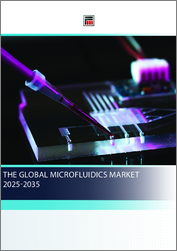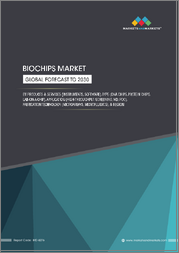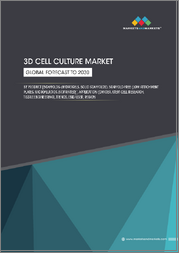
|
시장보고서
상품코드
1574328
세계의 마이크로플루이딕스 시장(2025-2035년)The Global Microfluidics Market 2025-2035 |
||||||
세계 마이크로플루이딕스 시장은 의료, 제약 및 산업 부문에서의 혁신적인 활용으로 인해 2035년까지 탁월한 성장 잠재력을 보여주고 있습니다. 미세한 규모로 유체를 조작하는 이 정교한 기술은 진단, 의약품 개발 및 공정 제어에 대한 기존의 접근 방식에 혁명을 불러일으키고 있습니다. 현재 의료 분야가 시장 점유율의 대부분을 차지하고 있으며, 현장 진단 및 제약 연구가 성장을 주도하고 있으며, 환경 모니터링, 식품 안전 및 공정 제어와 같은 산업 분야는 큰 성장 잠재력을 보여주고 있습니다.
재료 과학, 제조 공정 및 디지털 통합 분야의 혁신은 제조 비용을 지속적으로 낮추고 장치 기능을 강화하여 광범위한 시장 채택을 가능하게 하고 있으며, AI, 자동화 및 고급 감지 기능의 통합은 새로운 응용 가능성과 시장 기회를 창출하고 있습니다. 주요 시장 성장 촉진요인으로는 신속 진단 솔루션에 대한 수요 증가, 제약 연구 투자 확대, 개인 맞춤형 의료에 대한 적용 확대 등이 있습니다. 제조 공정이 개선되고 비용이 감소함에 따라 열 관리와 같은 분야의 기존 및 신규 응용 분야 모두에서 시장 채택이 가속화될 것입니다.
이 보고서는 세계 마이크로플루이딕스 시장을 조사 분석하여 2025-2035년 시장 역학, 기술 혁신 및 성장 기회에 대한 심층적인 고찰을 제공합니다.
목차
제1장 주요 요약
- 시장 규모
- 새로운 동향과 기술
- 시장 성장 촉진요인
- 시장 성장 억제요인
- 시장 기회
- 경쟁 구도 개요
제2장 서론
- 마이크로플루이딕스 기술 유형
- 연속 플로우 마이크로플루이딕스
- 액적 기반 마이크로플루이딕스
- 디지털 마이크로플루이딕스
- 종이 기반 마이크로플루이딕스
제3장 세계 시장 규모와 예측(2025년-2035년)
- 시장 전체 규모와 성장률
- 시장 규모(2020년-2024년)
- 시장 규모 예측(2025년-2035년)
- 시장 세분화 : 최종 용도 시장별
- 소비자 시장
- 산업 시장
- 의료 시장
- 지역 시장 분석
- 북미
- 유럽
- 아시아태평양
- 기타 지역
제4장 시장과 응용
- 진단
- 개요
- 새로운 동향
- 감염증
- 종양
- 심장
- 기타
- 제약 및 생명과학 연구
- 약제 스크리닝
- 유전체학
- 단백질체학
- 세포 분석
- 잉크젯 인쇄
- 소비자용 인쇄
- 산업 인쇄
- 3D 프린팅
- 환경 및 식품 안전 시험
- 수질 분석
- 식품 오염물질 탐지
- 토양 분석
- 기타(예 : 화장품, 농업)
- 화장품 및 퍼스널케어 제조
- 자동차 유체 분석
- 에너지 생산 모니터링
- 재료 제조
- 화학 처리
- 농업
- 모듈 유형
- 마이크로플루이딕스 칩
- 펌프 및 밸브
- 센서 및 검출기
- 마이크로플루이딕스 카트리지
- 기타
- 재료
- 폴리머
- 유리 웨이퍼
- 실리콘 웨퍼
- 종이 및 기타 재료
제5장 시장 동향
- 소비자 시장 동향
- 잉크젯 인쇄 기술 진화
- 새로운 소비자용 진단·웰니스 디바이스
- 산업 시장 동향
- 환경·식품 안전 시험 진보
- 석유 시험과 농업 이용
- 전자기기 냉각 솔루션
- 의료 시장 동향
- POC(Point of Care) 진단 진화
- Drug Discovery와 의약품 개발 마이크로플루이딕스
- 차세대 시퀀싱 진보
- 생체 모방 시스템과 장기 칩(Organ-on-a-Chip)
- 세포 분석과 치료에의 응용
제6장 공급망 분석
- 원재료·컴포넌트 공급업체
- 마이크로플루이딕스 칩 제조업체
- 모듈·디바이스 integrator
- 최종사용자
제7장 기술 동향과 혁신
- 바이오센서 개발
- 세포치료용 광센서
- POC(Point of Care) 진단용 실리콘 기반 바이오센서
- 재료 혁신
- 폴리머 기술 진보
- PDMS 대체품과 하이브리드 재료
- 유리와 실리콘 웨퍼 혁신
- 제조 동향
- 폴리머 제조 진보
- 실리콘과 유리 제조 기술
- 백엔드 프로세스와 통합
- 표면 처리와 코팅
- 신기술
- AI와 머신러닝 통합
- 마이크로플루이딕스 3D 프린팅
- 종이 기반 마이크로플루이딕스
제8장 규제 상황
- 마이크로플루이딕스 디바이스 규제 구조 개요
- FDA 규제(미국)
- 마이크로플루이딕스 디바이스 분류
- 시판전 승인(PMA) 프로세스
- 510(k) 승인 프로세스
- CE 마킹(유럽)
- 의료기기 규칙(MDR)
- 체외진단 용의료기기 규칙(IVDR)
- 적합성 평가 절차
- NMPA 규제(중국)
- 의료기기 등록
- 임상시험 요건
- 제조·품질관리 기준
제9장 향후 전망과 시장 기회
- 새로운 용도와 이용 사례
- 뉴로 테크놀러지
- 마이크로플루이딕스에 대한 생성형 AI의 잠재적 영향
- 정밀의료와 맞춤형 의료 마이크로플루이딕스
- 개발도상국 기회
제10장 기업 개요(기업 200개사 개요)
제11장 부록
제12장 참고 문헌
LSH 24.11.07The global microfluidics market demonstrates exceptional growth potential through 2035, driven by transformative applications across healthcare, pharmaceuticals, and industrial sectors. This sophisticated technology, which manipulates fluids at microscopic scales, continues to revolutionize traditional approaches to diagnostics, drug development, and process control. Medical applications currently dominate market share, with point-of-care diagnostics and pharmaceutical research leading growth, while industrial applications in environmental monitoring, food safety, and process control show substantial expansion potential.
Technological innovations in materials science, manufacturing processes, and digital integration continue to reduce production costs and enhance device functionality, enabling broader market adoption. The integration of artificial intelligence, automation, and advanced sensing capabilities creates new application possibilities and market opportunities. Key market drivers include increasing demand for rapid diagnostic solutions, growing investment in pharmaceutical research, and expanding applications in personalized medicine. As manufacturing processes improve and costs decrease, market adoption accelerates across both traditional and emerging applications in areas such as thermal management.
"The Global Microfluidics Market 2025-2035" providing detailed insights into market dynamics, technological innovations, and growth opportunities from 2025 to 2035. Report contents include: The microfluidics market is experiencing transformative growth driven by breakthroughs in point-of-care diagnostics, drug discovery applications, and personalized medicine.
Report contents include:
- End-Market Segmentation
- Medical Market:
- In-vitro diagnostics
- Drug discovery and development
- Genomics and proteomics
- Point-of-care testing
- Personalized medicine applications
- Organ-on-chip platforms
- Industrial Market:
- Environmental monitoring
- Food and beverage testing
- Oil and gas analysis
- Electronic cooling solutions
- Process control applications
- Quality assurance systems
- Consumer Market:
- Inkjet printing technologies
- Consumer diagnostics
- Wearable devices
- Personal care applications
- Medical Market:
- Developments across materials, manufacturing processes, and integration technologies:
- Advanced polymer technologies
- PDMS alternatives
- Glass and silicon innovations
- Paper-based platforms
- Hybrid materials development
- 3D printing applications
- Injection molding innovations
- Hot embossing techniques
- Wafer-level packaging
- Integration technologies
- Emerging Technologies:
- AI and machine learning integration
- Biosensor developments
- Digital microfluidics
- Paper-based systems
- Organ-on-chip platforms
- Applications and Market Opportunities
- Diagnostics:
- Infectious disease testing
- Oncology applications
- Cardiovascular diagnostics
- Neurological testing
- Genetic screening
- Pharmaceutical Research:
- Drug screening platforms
- Genomics applications
- Proteomics research
- Cell analysis systems
- High-throughput screening
- Environmental and Industrial:
- Water quality analysis
- Food safety testing
- Industrial process control
- Environmental monitoring
- Agricultural applications
- Diagnostics:
- Market Drivers and Challenges
- Regulatory Landscape
- Detailed profiles of 200 companies including 3M, 10X Genomics, Abbott, AbCellera, Accelix, Achira Labs, AGC, Agilent Technologies, AgPlus Diagnostics, Akonni Biosystems, ALiA Biotech, Aline inc, Allozymes, Alveo, Amberstone Biosciences Inc., Ande Corporation, Arrayit Corporation, Astraveus, Atomica, Atrandi Biosciences, AxBio, Baebies, Bartels Mikrotechnik, Becton Dickinson, BforCure, BGI, Bi.Flow Systems GmbH, Binx Health, Biocartis, Biomensio, bioMerieux, Bionano Genomics, Bioneer, Bio-Rad, BioSurfit, Biotechne, Boehringer Ingelheim, Bosch, Bruker Cellular Analysis, CapitalBiotech Corporation, Capsum, Cellbox Labs, Cellares, CellFE, Cellix Ltd., Charles River Laboratories, ClexBio, CN Bio, Cytovale, Danaher Corporation, Deepcell, Dermagnostix, DiaSorin Molecular, DNA electronics (DNAe), DNA Nudge, Dolomite Microfluidics, Eden Microfluidics, Element Biosciences, Elveflow, Emulate Bio, ENPLAS, Epicore Biosystems, Epigem, Evonetix, FEMTOprint, FinalSpark, Finnadvance, FLEXOMICS LLC, Fluigent, Fluxergy, Genalyte, GenSpeed Biotech GmbH, Hesperos Inc., Hicomp Microtech, Hochuen Medical, IDEX Health & Science, iLine Microsystems, Illumina, Imec, iMiGiNE, IMT AG, Inflammatix, Inorevia, Integra Biosciences, Invetech, InziGn Pte Ltd., Klearia, Kloe, Kypha, LightDeck, LioniX, LuminUltra Technologies, Lunaphore Technologies, Medimate, Mekonos, MeMed BV, Memo Therapeutics AG, Menarini Silicon Biosystems, Mesa labs, MGI Tech, MiCo BioMed USA, Microcaps AG, Microfluidic ChipShop, Micron Biomedical, Micronit, MicrofluidiX, Micropoint Technologies, microTEC, miDiagnostics, Miltenyi Biotec, Mimetas, Minos Biosciences, Mission Bio, Molbio Diagnostics, MZP tech, Nag Bioscience, NanoCellect, NanoDx, NanoEntek, Nanomix, NanoPass, NanoScribe, Netri, Nicoya, Nortis, Nuclera, Nutcracker Therapeutics, Okomera, Ondavia, Opgen Group, OPKO, Optolane Technologies, Orange Biomed, Osler Diagnostics, Oxford Nanopore Technologies, Pacific Biosciences, Paragraf, Parallel Fluidics, Pattern Bioscience, Perkinelmer, Philips Engineering Solutions, Phillips Medisize, PixCell Medical, Potomac Photonics (Goodfellow), Precision Nanosystems, Qiagen, Qorvo Biotechnologies, Quanterix, QuantuMDx, Quantum-Si, QuidelOrtho, Qurin Diagnostics, Rab-Microfluidics and more....
- Future Outlook Analysis of emerging opportunities
- Supply Chain Analysis:
- Raw materials suppliers
- Component manufacturers
- Device integrators
- End-user markets
- Distribution channels
- Market Opportunities
TABLE OF CONTENTS
1. EXECUTIVE SUMMARY
- 1.1. Market Size
- 1.2. Emerging Trends and Technologies
- 1.3. Market Drivers
- 1.3.1. Advancements in Point-of-Care Diagnostics
- 1.3.1.1. Rapid Testing for Infectious Diseases
- 1.3.1.2. Chronic Disease Management
- 1.3.1.3. Decentralized Healthcare Trends
- 1.3.2. Increasing Demand for Personalized Medicine
- 1.3.2.1. Genomics and Proteomics Applications
- 1.3.2.2. Targeted Drug Delivery Systems
- 1.3.2.3. Companion Diagnostics
- 1.3.3. Growth in Drug Discovery and Life Sciences Research
- 1.3.3.1. High-Throughput Screening
- 1.3.3.2. Organ-on-a-Chip Models
- 1.3.3.3. Single-Cell Analysis
- 1.3.4. Emerging Applications in Industrial and Environmental Monitoring
- 1.3.4.1. Water Quality Testing
- 1.3.4.2. Food Safety Analysis
- 1.3.4.3. Industrial Process Control
- 1.3.1. Advancements in Point-of-Care Diagnostics
- 1.4. Market Restraints
- 1.4.1. High Initial Costs and Complexities in Manufacturing
- 1.4.2. Standardization and Regulatory Challenges
- 1.4.3. Limited Awareness and Adoption in Emerging Markets
- 1.4.4. Scaling Up Production While Maintaining Quality
- 1.4.5. Competing Technologies and Alternative Solutions
- 1.5. Market Opportunities
- 1.5.1. Integration of AI and IoT in Microfluidic Devices
- 1.5.2. Lab-to-fab
- 1.5.3. Novel Applications in Organ-on-a-Chip and 3D Cell Culture
- 1.5.4. Space Research Applications
- 1.5.5. Synthetic Biology
- 1.5.6. Advanced Materials Development
- 1.5.7. Food Safety and Quality
- 1.6. Competitive Landscape Overview
2. INTRODUCTION
- 2.1. Types of Microfluidic Technologies
- 2.1.1. Continuous-flow Microfluidics
- 2.1.2. Droplet-based Microfluidics
- 2.1.3. Digital Microfluidics
- 2.1.4. Paper-based Microfluidics
3. GLOBAL MARKET SIZE AND FORECAST (2025-2035)
- 3.1. Overall Market Size and Growth Rate
- 3.1.1. Historical Market Size (2020-2024)
- 3.1.2. Forecast Market Size (2025-2035)
- 3.2. Market Segmentation by End-Use Markets
- 3.2.1. Consumer Market
- 3.2.1.1. Inkjet Printing
- 3.2.1.2. Consumer Diagnostics
- 3.2.1.3. Wearable Devices
- 3.2.2. Industrial Market
- 3.2.2.1. Environmental Monitoring
- 3.2.2.2. Food and Beverage Testing
- 3.2.2.3. Oil and Gas Analysis
- 3.2.2.4. Electronic Cooling Solutions
- 3.2.3. Medical Market
- 3.2.3.1. In-Vitro Diagnostics
- 3.2.3.2. Drug Discovery and Development
- 3.2.3.3. Genomics and Proteomics
- 3.2.3.4. Point-of-Care Testing
- 3.2.1. Consumer Market
- 3.3. Regional Market Analysis
- 3.3.1. North America
- 3.3.2. Europe
- 3.3.3. Asia-Pacific
- 3.3.4. Rest of the World
4. MARKETS AND APPLICATIONS
- 4.1. Diagnostics
- 4.1.1. Overview
- 4.1.2. Emerging Trends
- 4.1.2.1. Artificial Intelligence Integration
- 4.1.2.2. Smartphone-Based Systems
- 4.1.2.3. Paper-Based Microfluidics
- 4.1.2.4. Digital Microfluidics
- 4.1.2.5. 3D-Printed Microfluidics
- 4.1.3. Infectious Diseases
- 4.1.3.1. Viral Infection Detection
- 4.1.3.2. Bacterial Infection Management
- 4.1.3.3. Emerging Pathogen Response
- 4.1.4. Oncology
- 4.1.4.1. Circulating Tumor Cell Analysis
- 4.1.4.2. Molecular Profiling and Monitoring
- 4.1.4.3. Treatment Response Monitoring
- 4.1.5. Cardiology
- 4.1.5.1. Acute Cardiac Event Management
- 4.1.5.2. Chronic Disease Monitoring
- 4.1.6. Others
- 4.1.6.1. Neurological Disorders
- 4.1.6.1.1. Blood-Brain Barrier Modeling
- 4.1.6.1.2. Neurodegenerative Disease Diagnostics
- 4.1.6.2. Endocrine Disorders
- 4.1.6.2.1. Diabetes Management
- 4.1.6.2.2. Thyroid Function Testing
- 4.1.6.3. Autoimmune Disease Diagnostics
- 4.1.6.3.1. Comprehensive Antibody Profiling
- 4.1.6.3.2. Inflammatory Response Analysis
- 4.1.6.4. Genetic Testing Applications
- 4.1.6.4.1. Prenatal Testing
- 4.1.6.4.2. Hereditary Disease Screening
- 4.1.6.5. Rare Disease Diagnostics
- 4.1.6.1. Neurological Disorders
- 4.2. Pharmaceutical and Life Science Research
- 4.2.1. Drug Screening
- 4.2.2. Genomics
- 4.2.3. Proteomics
- 4.2.4. Cell Analysis
- 4.3. Inkjet Printing
- 4.3.1. Consumer Printing
- 4.3.2. Industrial Printing
- 4.3.3. 3D Printing
- 4.4. Environmental and Food Safety Testing
- 4.4.1. Water Quality Analysis
- 4.4.2. Food Contaminant Detection
- 4.4.3. Soil Analysis
- 4.5. Others (e.g., Cosmetics, Agriculture)
- 4.5.1. Cosmetics and Personal Care Manufacturing
- 4.5.2. Automotive Fluids Analysis
- 4.5.3. Energy Production Monitoring
- 4.5.4. Materials Manufacturing
- 4.5.5. Chemical Processing
- 4.5.6. Agriculture
- 4.6. Module Types
- 4.6.1. Microfluidic Chips
- 4.6.2. Pumps and Valves
- 4.6.3. Sensors and Detectors
- 4.6.4. Microfluidic Cartridges
- 4.6.5. Others
- 4.7. Materials
- 4.7.1. Polymer
- 4.7.1.1. Thermoplastics (PMMA, COC, PS)
- 4.7.1.2. Thermosets
- 4.7.1.3. PDMS (Polydimethylsiloxane)
- 4.7.2. Glass Wafers
- 4.7.3. Silicon Wafers
- 4.7.4. Paper and Other Materials
- 4.7.4.1. Multiplexed Analysis Platforms
- 4.7.4.2. Integration with IoT for Real-time Monitoring
- 4.7.1. Polymer
5. MARKET TRENDS
- 5.1. Consumer Market Trends
- 5.1.1. Evolution of Inkjet Printing Technologies
- 5.1.1.1. Continuous Inkjet (CIJ) vs. Drop-on-Demand (DOD)
- 5.1.1.2. Advancements in Printhead Technology
- 5.1.1.3. Eco-friendly Inks and Sustainability Trends
- 5.1.2. Emerging Consumer Diagnostics and Wellness Devices
- 5.1.2.1. At-home Testing Kits
- 5.1.2.2. Wearable Microfluidic Devices
- 5.1.2.3. Personalized Nutrition and Hydration Monitoring
- 5.1.1. Evolution of Inkjet Printing Technologies
- 5.2. Industrial Market Trends
- 5.2.1. Advancements in Environmental and Food Safety Testing
- 5.2.1.1. Rapid On-site Detection Systems
- 5.2.1.2. Multiplexed Analysis Platforms
- 5.2.1.3. Integration with IoT for Real-time Monitoring
- 5.2.2. Applications in Oil Testing and Agriculture
- 5.2.2.1. In-situ Oil Analysis
- 5.2.2.2. Precision Agriculture and Crop Management
- 5.2.2.3. Soil Health Monitoring
- 5.2.3. Electronic Cooling Solutions
- 5.2.3.1. Microfluidic Cooling for High-Performance Computing
- 5.2.3.2. Innovations in Data Center Cooling
- 5.2.3.2.1. Thermal management
- 5.2.3.3. Challenges and Opportunities in Chip-level Cooling
- 5.2.1. Advancements in Environmental and Food Safety Testing
- 5.3. Medical Market Trends
- 5.3.1. Point-of-Care Diagnostics Evolution
- 5.3.1.1. Smartphone-integrated Diagnostics
- 5.3.1.2. Multiplexed POC Platforms
- 5.3.1.3. Emerging Biomarkers and Test Types
- 5.3.2. Microfluidics in Drug Discovery and Development
- 5.3.2.1. High-Throughput Screening Platforms
- 5.3.2.2. Organ-on-a-Chip for Drug Testing
- 5.3.2.3. Personalized Drug Efficacy Testing
- 5.3.3. Next-Generation Sequencing Advancements
- 5.3.3.1. Microfluidic-based Library Preparation
- 5.3.3.2. Single-cell Sequencing Platforms
- 5.3.3.3. Long-read Sequencing Technologies
- 5.3.4. Microphysiological Systems and Organ-on-a-Chip
- 5.3.4.1. Multi-organ Systems
- 5.3.4.2. Disease Modelling
- 5.3.4.3. Personalized Medicine Applications
- 5.3.5. Cell Analysis and Therapy Applications
- 5.3.5.1. Circulating Tumor Cell (CTC) Analysis
- 5.3.5.2. CAR-T Cell Manufacturing
- 5.3.5.3. Stem Cell Research and Therapy
- 5.3.1. Point-of-Care Diagnostics Evolution
6. SUPPLY CHAIN ANALYSIS
- 6.1. Raw Materials and Components Suppliers
- 6.2. Microfluidic Chip Manufacturers
- 6.3. Module and Device Integrators
- 6.4. End-Users
7. TECHNOLOGY TRENDS AND INNOVATIONS
- 7.1. Development of Biosensors
- 7.1.1. Photonic Sensors for Cell Therapy
- 7.1.1.1. Applications in Cell Sorting and Analysis
- 7.1.1.2. Challenges and Future Prospects
- 7.1.2. Silicon-Based Biosensors for Point-of-Care Diagnostics
- 7.1.2.1. CMOS-Integrated Biosensors
- 7.1.2.2. Label-free Detection Methods
- 7.1.2.3. Multiplexed Sensing Platforms
- 7.1.1. Photonic Sensors for Cell Therapy
- 7.2. Materials Innovations
- 7.2.1. Advancements in Polymer Technologies
- 7.2.1.1. High-Performance Thermoplastics
- 7.2.1.2. Biodegradable Polymers
- 7.2.1.3. Surface Modification Techniques
- 7.2.2. PDMS Alternatives and Hybrid Materials
- 7.2.2.1. Thermoplastic Elastomers
- 7.2.2.2. Fluoropolymers
- 7.2.2.3. Glass-Polymer Hybrids
- 7.2.3. Glass and Silicon Wafer Innovations
- 7.2.3.1. Ultra-thin Glass Substrates
- 7.2.3.2. 3D-Structured Silicon
- 7.2.3.3. Nanoporous Materials
- 7.2.1. Advancements in Polymer Technologies
- 7.3. Manufacturing Trends
- 7.3.1. Polymer Manufacturing Advancements
- 7.3.1.1. Injection Molding Innovations
- 7.3.1.2. Hot Embossing Techniques
- 7.3.1.3. 3D Printing of Microfluidic Devices
- 7.3.2. Silicon and Glass Manufacturing Techniques
- 7.3.2.1. Deep Reactive Ion Etching (DRIE)
- 7.3.2.2. Wafer-level Packaging
- 7.3.2.3. Through-Silicon Vias (TSVs)
- 7.3.3. Backend Processes and Integration
- 7.3.3.1. Bonding Technologies
- 7.3.4. Surface Treatments and Coatings
- 7.3.4.1. Integration of Electronics and Microfluidics
- 7.3.1. Polymer Manufacturing Advancements
- 7.4. Emerging Technologies
- 7.4.1. AI and Machine Learning Integration
- 7.4.1.1. Automated Design of Microfluidic Circuits
- 7.4.1.2. Predictive Maintenance of Microfluidic Systems
- 7.4.1.3. Data Analysis and Interpretation
- 7.4.2. 3D Printing in Microfluidics
- 7.4.2.1. Stereolithography (SLA) for Microfluidics
- 7.4.2.2. Multi-material 3D Printing
- 7.4.2.3. Bioprinting of Tissue Constructs
- 7.4.3. Paper-Based Microfluidics
- 7.4.3.1. Fabrication Methods
- 7.4.3.2. Applications in Low-Resource Settings
- 7.4.3.3. Integration with Smartphones for Readout
- 7.4.1. AI and Machine Learning Integration
8. REGULATORY LANDSCAPE
- 8.1. Overview of Regulatory Framework for Microfluidic Devices
- 8.2. FDA Regulations (USA)
- 8.2.1. Classification of Microfluidic Devices
- 8.2.2. Premarket Approval (PMA) Process
- 8.2.3. 510(k) Clearance Process
- 8.3. CE Marking (Europe)
- 8.3.1. Medical Device Regulation (MDR)
- 8.3.2. In Vitro Diagnostic Regulation (IVDR)
- 8.3.3. Conformity Assessment Procedures
- 8.4. NMPA Regulations (China)
- 8.4.1. Registration Process for Medical Devices
- 8.4.2. Clinical Trial Requirements
- 8.4.3. Manufacturing and Quality Control Standards
9. FUTURE OUTLOOK AND MARKET OPPORTUNITIES
- 9.1. Emerging Applications and Use Cases
- 9.1.1. Microfluidics in Space Research
- 9.1.2. Microbiome Analysis and Engineering
- 9.2. Neurotechnology
- 9.2.1. Neurotechnology and Brain-on-a-Chip
- 9.2.2. Synthetic Biology and Biofabrication
- 9.2.3. Advanced Materials Testing and Development
- 9.3. Potential Impact of Generative AI on Microfluidics
- 9.3.1. AI-Driven Design Optimization
- 9.3.2. Predictive Modeling of Fluid Dynamics
- 9.3.3. Automated Data Analysis and Interpretation
- 9.4. Microfluidics in Precision Medicine and Personalized Healthcare
- 9.4.1. Liquid Biopsy and Circulating Biomarkers
- 9.4.2. Personalized Drug Screening
- 9.4.3. Microfluidic Devices for Continuous Health Monitoring
- 9.5. Opportunities in Developing Economies
- 9.5.1. Point-of-Care Diagnostics for Resource-Limited Settings
- 9.5.2. Affordable Microfluidic Solutions for Agriculture
- 9.5.3. Environmental Monitoring in Rapidly Industrializing Regions
10. COMPANY PROFILES (200 company profiles)
11. APPENDICES
- 11.1. Glossary of Terms
- 11.2. List of Abbreviations
- 11.3. Research Methodology



















